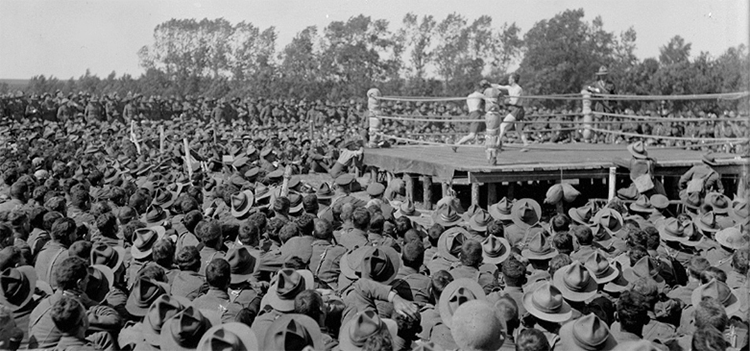100 years ago, our great-great grandfathers were in the trenches of France, and fighters on both sides of the war had to while away their time when they weren’t actively working or fighting. And it takes a lot to keep your morale up and your terror down when your work hours are filled with enemy mortars, artillery, and machine guns.
Here are six games and other activities they turned to:
(Note that this article uses information from the letters of British soldiers written in 1915. Unless there’s another link cited, the letters are pulled from this digital file from the British National Archives.)
1. Boxing

A large crowd of World War One soldiers watching two boxers sparring in a ring during the boxing championships at the New Zealand Divisional Sports at Authie, France, in July 1918.
(Henry Armytage Sanders)
Unsurprisingly, some of the top activities were a little violent, and boxing was a top activity. These could be tournaments where one company or platoon fought another, but they were also often just quick, relatively impromptu matchups. Soldiers talked about the fights in letters, and it seems that the more violent the fight was, the better. One British soldier wrote:
“We are having a good time here in the way of concerts, sports, boxing tournaments etc. The latter was great especially the bout between a Farrier Sergeant and a cook’s mate. They biffed at one another until neither could stand, it was awfully funny.”
2. Football (American and European)

The “Christmas Truce” took place around Christmas, 1914, and included some sports events, like football matches.
(Illustration by A. C. Michael of the Christmas Truce created for “The Illustrated London News”)
Football was also popular, but was obviously a team-based event that lent itself well to one unit playing against another. American and European football were both played in the trenches, though it’s obvious that European football would be more popular everywhere but the American Expeditionary Force.
The famous Christmas Truce soccer game was part of this tradition, but games were commonly played between allies rather than adversaries. One soldier wrote in a 1915 letter that his unit played against a rival battery in an old cabbage patch. The patch made a bad football pitch, but the letter-writer won, so he wasn’t sore about it.
3. Wrestling (sometimes on mules)

World War I Gurkhas wrestle on the regimental transport mules.
(H. D. Girdwood, British Library)
Wrestling, like boxing, was popular for the same reasons, but there is a special, odd caveat that wrestling matches were sometimes held on mules. Yeah, like the animals. This activity was featured during a special sports day in October, 1917, but it didn’t include details of the sport.
Likely, it consisted of two riders wrestling until one knocked the other off the gallant steed, but I like to imagine that the mules were combatants as well, because cartoons don’t become real as often as I would like.
4. Wheelbarrow racing, pillow fights, and other improvised events

Scottish troops and other onlookers watch troops taking part in an organized sports day.
(British photo from the National Library of Scotland)
Other events on that sports day included pillow fights and “wheelbarrow” races. The events were organized to improve morale, but anyone who has spent time with troops in the field knows that games like these are common any time infantrymen get bored.
These games could include pretty much anything the soldiers could think of. The easier it is to play the game without specific gear, the better.
5. Plays and other performances
But when troops needed to entertain themselves in an organized way, they had more choices than just sports and fighting one another. Sometimes, this resulted in soldiers holding their own plays and concerts, but they could also enjoy performances by professionals when they came around.
Another British letter written in 1915 but digitized in 2014 was penned by a soldier who gave a short, blow-by-blow of the barracks activities. While he was writing, one soldier did a performance where he acted like a dancing monkey with a small cup for change and another soldier started playing the accordion.
6. “Don’t Get Annoyed With Me” and other board games

A 1929 edition of “Mensch Aergere Dich Nicht,” a game that led to the American game of “Sorry.” The German game became popular in Central Powers trenches in World War I.
(Vitavia, CC BY-SA 4.0)
Troops on both sides of the trenches used board games to pass the time because, obviously, video games weren’t a thing yet. Plenty of games were popular in the war. Checkers could be played with bits of metal or buttons on a hand-drawn board, or a travel game of Chess could be popular. And no war has been fought without playing cards since someone figured out how to paint faces on bits of paper.
But German troops could enjoy a game that had been invented just in time for the war, “Mensch Aergere Dich Nicht,” which translates to “Don’t Get Annoyed With Me.” Players moved game pieces around a board and tried to get them “Home,” but the opposing player could knock a piece off just before it reached safety and thereby piss off the other player.
If it sounds familiar, that’s because the game “Sorry” is a close descendant.
This article originally appeared on We Are The Mighty
More From We Are The Mighty
7 Key Facts About the USO’s 75 Years of Service
13 of the Best Military Morale Patches
8 Famous People Who Served on D-Day
6 Things You’d Take Back Before Leaving the Military
Follow We Are The Mighty on Twitter
READ NEXT: FAMOUS ACTORS WHO SERVED IN THE MILITARY
READ NEXT: 5 THINGS YOU LEARN FROM BAND OF BROTHERS
READ NEXT: 5 OF THE MOST ACCURATE MILITARY REPRESENTATIONS ON SCREEN










